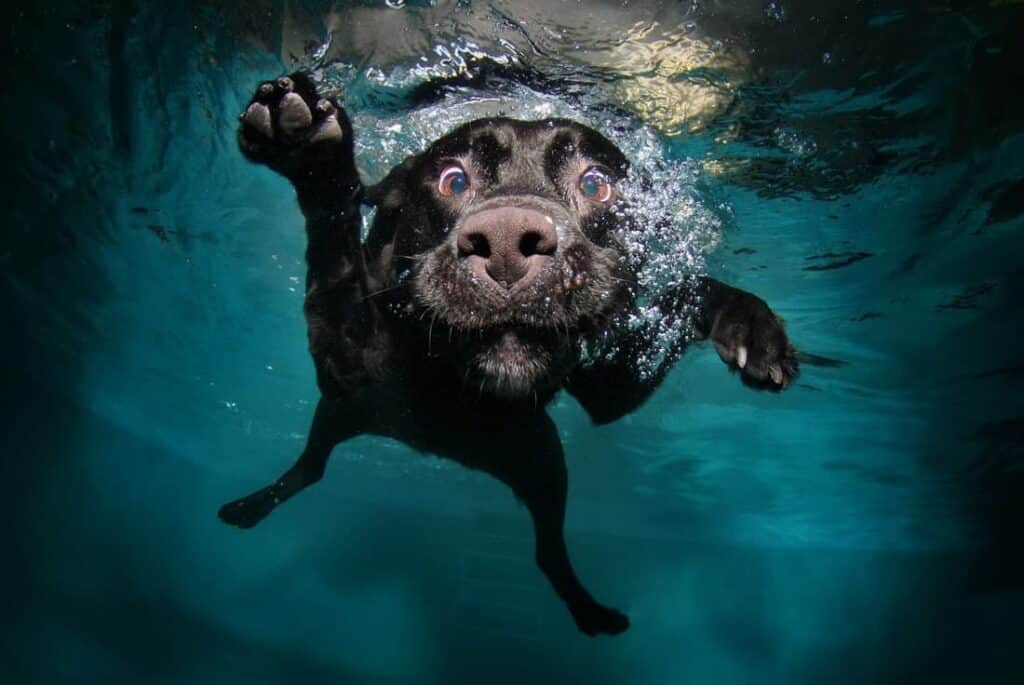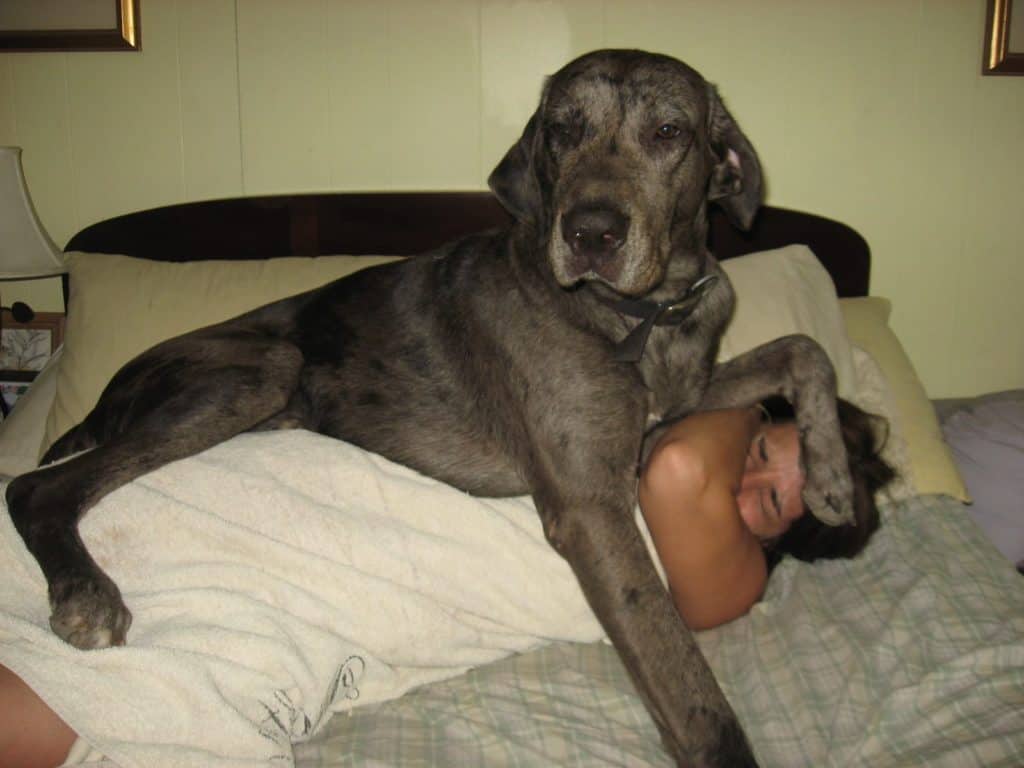
At what age do dogs Swim? In a rush and want a quick answer?
Dogs can swim as early as 7 weeks of age. But that, of course, can differ depending on the breed of your dog.
Introducing a young, inexperienced dog to water, whether it’s a hunting dog or otherwise, is a matter of desensitization.
We accomplish it just as we would any new situation—progressively. In case it needs to be said: Never “teach” your pup to swim by tossing him off a dock or forcing him into the water. That’s a recipe for a land-loving dog.
Dogs can be introduced to water as early as 7 weeks of age. But that, of course, can differ depending on the breed of your dog.
It is best to check with your own vet as to what age they recommend the pup learns to swim as there are many different opinions on this. The most important thing is not to rush this, take it slowly so that the pup gains confidence and does not panic.
If you do have access to a stream or river that is shallow enough, where the pup can chase you, run after a ball, etc, do try this, it does make the introduction easier.
If you have an existing dog that can swim, have the older dog go into the water first.
Pups will often follow the lead of an older dog, but be with the pup and help to hold it until it is secure enough and confident to swim by itself.
Introducing your dog to the pool
Many breeds are natural-born swimmers. Many retrievers and spaniels will swim with little encouragement, but dogs with body types less suited to swimming, like Bulldogs, may need more encouragement and should wear a life jacket when swimming.
Start off in shallow, warm water, where the pup can easily stand. You should introduce your pup to water only after he understands basic obedience skills and the two of you have developed a trusting relationship.
No problem if you’ve had a kids’ pool in the dog’s yard—actual swimming is different. If you make your intro to water slow and fun, you should end up with a dog that views swimming as a great reward.

The best way to ensure that your dog goes in the water at the first introduction is to get into the water with the pup.
Most dogs don’t like being left onshore and will follow their handler right in.
I begin with several sessions of heelwork in the shallows, with no expectations for swimming. Once he’s relaxed, we start to play with a bumper (retriever), or favorite toy (other dogs).
Make sure there are no drop-offs or other spots where your novice pup could lose his footing and get dunked.
Usually, after a few quick retrieves in elbow-deep water, the dog forgets about the water altogether.
Slowly and progressively toss the object farther from shore. We’re talking only a foot or two of additional distance with each toss and only a few tosses each day to avoid boredom.
Water introductions can take several days depending on the dog.
When your pup is showing no hesitation toward the water, toss the object far enough to require him to swim to reach it. Usually, that’s all it takes.
It is best practice to use a life jacket when he is first learning to swim. Most pet supply stores stock life jackets in many sizes and styles appropriate for all body types.
Look for a lifejacket with a handle that you can use to guide your dog in the water and a D-ring to attach a leash.
Before using the lifejacket in the water, put it on your dog at home and get him comfortable with it by feeding him dinner while he wears it, as well as rewarding him with treats while he wears it.

We recommend this Vivaglory Ripstop Dog Life Jacket – Find the latest price on Amazon here.

Training your dog to swim
The best way to ensure that your dog goes in the water at the first introduction is to get into the water with the pup.
Most dogs don’t like being left onshore and will follow their handler right in. Begin with several sessions of heelwork in the shallows, with no expectations for swimming.
Once he’s relaxed, start to play with a bumper (retriever), or favorite toy (other dogs).

ChuckIt! Amphibious Bumper Floating Fetch Toy – Find it on Amazon here.
Make sure there are no drop-offs or other spots where your novice pup could lose his footing and get dunked.
Usually, after a few quick retrieves in elbow-deep water, the dog forgets about the water altogether.
Slowly and progressively toss the object farther from shore. We’re talking only a foot or two of additional distance with each toss and only a few tosses each day to avoid boredom.
Water introductions can take several days depending on the dog. When your pup is showing no hesitation toward the water, toss the object far enough to require him to swim to reach it. Usually, that’s all it takes.
No? He won’t pick up his feet and start to swim? Lead the dog out with you until he’s got to swim. Quickly, they catch on and the swimming reflex is triggered.
Once you’ve got him swimming. Try this gradual build-up to water retrieves:
- Wade out with the dog at heel. Toss the bumper just far enough to require him to swim.
- Heel the dog back to the bank.
- Once he’s calm, send him for the bumper. Making him wade out with you to throw the bumper requires him to remember the location of the bumper. It builds calmness, focus, and problem-solving ability. Throwing an object and immediately sending your dog can make him uncontrollable.
- Meet your dog in the water to take the bumper to avoid any fraps on the bank.
- Keep the distractions low. No other dogs, kids, boats, gunfire, real birds, or any of that.
With a solid introduction to water, layering progressively more complicated skills—like directional signals—will be easy.
Take your dog swimming in the sea
All of us enjoy a nice swim at the beach and there is no reason why you cannot share that happiness with your dog.
If you do plan a day out with your puppy at the beach, the following tips would be helpful:
- A dog-friendly beach is ideal for you and your dog since it has plenty of shallow water to play in, and a gradual slope to go deeper at her own pace. And, there may be other dogs to play with and learn from.
- Observe how far into the water your dog is willing to go. Don’t ever force your puppy to go deeper, instead, run with him, and throw toys for him to retrieve within his comfort zone. And be prepared to go in the water to get the toy out if he isn’t ready. In fact, the more you are in the water, the more he will see it as fun.
- Encourage your dog. Training sessions that are short, fully-focused, and filled with positive experience always work the best. If he wants to leave the water to allow him to do so and offer praise when he’s back to his safe zone.
- Go in the water yourself. Puppies are natural followers, and older dogs may also swim out to you with encouragement. Just remember to praise any small gains. But, don’t expect your dog to go in the water if you won’t. Puppies and dogs look up to you as their leader, so walk the talk, or swim the talk!
A list of the best and worse swimming dogs – In no order.
| Best Swimmers | Worst Swimmers |
| Portuguese Water Dog | Bulldog |
| Labrador Retriever | Pug |
| Newfoundland | Dachshund |
| German Shorthaired Pointer | Pekingese |
| Irish Water Spaniel | Basset Hound |
| Chesapeake Bay Retriever | Boxer |
| Golden Retriever | Staffordshire Bull Terrier |
Things to keep in mind when your dog is swimming.
- Some dogs can be overwhelmed by large bodies of water. Try starting with an empty baby pool in your yard. Get your dog comfortable stepping in while the pool is empty before slowly adding water. Reward your dog for getting in and he’ll soon be happily jumping in every chance he gets!
- Start young! Get your puppy comfortable with water as soon as you bring him home! Your bathtub or a baby pool with an inch or two of water make great places to introduce young puppies. You can also carry small puppies into the water and help them swim back to shore or another person.
- If your dog won’t step off a pool step to start swimming try a pond or lake where they can gradually wade deeper rather than a sudden drop-off.
The majority of pups will appear to splash and only use their front legs initially, rather than swim which is really not very effective, so make sure you are involved in the exercise sessions.
Only one bad experience (one event learning) can result in a pup refusing to get back into the water.
If a pup is introduced to the water after 6 months of age, it seems to take longer to get used to it, so do start the preparation as young as possible.
Contrary to popular belief, not all dogs can learn to swim. It may be that the dog is overweight and breeds such as Bulldogs, Bull Terrier and the French bulldog are well known for swimming ‘like rocks’.
Another point owners should bear in mind is to start the pool work when the water and weather is warm. A lot of dogs don’t like cold water and it may not be the swimming they don’t like, but rather the temperature of the water.
My top safety tips for when your dog is swimming
1 Choose a quiet, shallow spot in the water
When you are introducing your dog to water the first time pick a shallow quiet spot. Very go too deep, You don’t want to make your dog nervous.
Start small and work your way up.
2 Get Your Dog a Life Vest
Getting a life vest for your dog is essential if you are going into the sea. You cant see how fast the current is running under the water, if your dog gets into trouble it will give you enough time to save your dog.
Its also recommended for a swimming pool if you are teaching your dog to swim for the first time. I recommend getting one like this.
3 Keep your dog on a leash while he learns
Use a dog leash if you haven’t got a life vest. It will be helpful in the early stages when training your dog in the pool.
4 Get into the water with your dog
This will be good for your dog’s confidence. You can swim together or play a ball game.
5 Take it Slow
Start slow and work your way up when your dog is ready. Do too much may knock their confidence. It should be fun for them.
6 Don’t Let Your Dog Drink From the Ocean or pool
Chlorine in pools and the salt in the ocean is bad news for dogs if too much is drunk. I have an article that is worth a read here called Will Chlorine In Swimming Pools Hurt My Dog.
7 Wash Your Dog After Swimming, including Clean your dog’s ears after a swim
This is important as salt and chlorine can cause ear infections and skin irritation.
Related questions
My dog seems to really dislike swimming. What should I do?
If your dog never comes to enjoy swimming, he can still enjoy going to the lake with you. Make sure he wears a life vest.
Booties wouldn’t hurt if the sand is sizzling. He also must have nonstop access to cool drinking water and must be able to get into the shade as often as he wants. When he starts to get hot, take a bucket and soak him frequently, especially his belly. Be aware, always, of signs of heat stress.
If you’re able to keep him cool, he’ll be able to enjoy his lake time with you safely, even if he never does learn to like swimming all that much.
I have read that dogs are ‘born-swimmers’. Why can’t my dog swim?
Some people mistakenly believe all dogs have a “swimming gene” and are born with the natural ability to swim.
But the reality is that while most dogs instinctively make a paddling motion if they happen to wind up in the water, it’s often the extent of their ability to swim.
Not every dog paddle is effective at keeping the animal afloat, and many dogs have no idea how to move toward shore or the side of the pool.
Dogs generally fall into one of three categories when it comes to swimming.
There are dogs that naturally take to the water, those who just aren’t built for the water and should stay safely ashore (unless in a hydrotherapy tank with a therapist hovering nearby), and dogs who can be taught to swim.
There are always exceptions to every rule, of course. There are dogs bred for waterwork who are terrified of the wet stuff. And there are those that by design shouldn’t be able to swim but manage to anyway.


